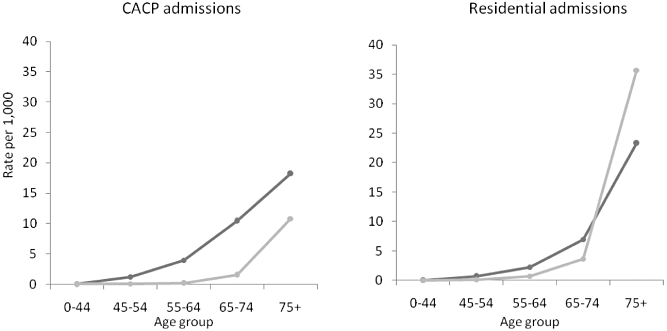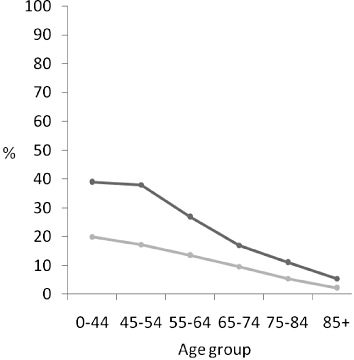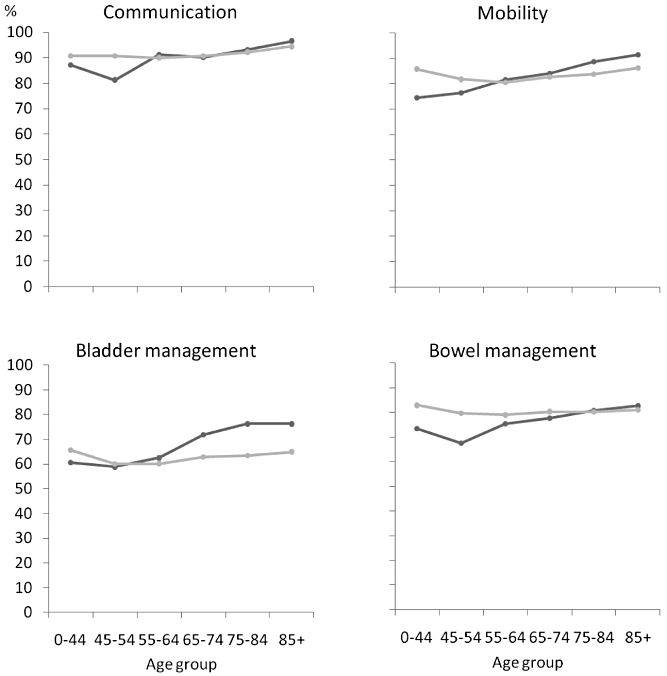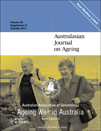Indigenous aged care service use and need for assistance: How well is policy matching need?
Abstract
Aim: To investigate the effectiveness of the Australian Government's aged care planning framework for Indigenous Australians, particularly the use of a lower planning age of 50 years.
Methods: We analysed published data and administrative datasets relating to population demographics, aged care assessments, admissions and usage, need for assistance and expenditure, comparing the Indigenous 50–69 and 70+ age groups with the non-Indigenous 70+ age group.
Results: Indigenous people aged 50–69 years have much lower utilisation, and a different pattern of utilisation, of aged care services than either Indigenous or non-Indigenous people aged 70 and over. Community-based services are much more important for Indigenous than non-Indigenous people, regardless of age.
Conclusion: The planning framework conflates the diverse needs of Indigenous people across a wide age range and does not set a meaningful target for service provision. It has not ensured the right balance of services across geographic areas and between different levels of care.
Introduction
Since the mid 1980s, Indigenous Australians have been designated a ‘special needs group’ in Australian Government aged care policy, and the age 50 years and over has been used to define the Indigenous target population for residential care and for a range of community-based care packages in the same way as the age 70 years is used for the non-Indigenous population [1]. The planning framework aims to match allocation of new aged care places with distribution and growth in the aged population and to determine the balance between residential and community care. The current Australian Government target is to provide 113 operational places (25 community care and 88 residential care) per 1000 people in the target population by 2011 [1].
The National Health and Hospitals Reform Commission recently recommended a new planning age of 85 years for the general population, noting that ‘further consideration’ is required for Indigenous people but ‘at a minimum’ the existing planning ratio should continue for Indigenous people [2]. Policy changes may follow the Productivity Commission review of aged care [3].
The main rationale for including the 50–69 year age group of the Indigenous population in the target population is the view that ‘conditions associated with ageing generally affect Aboriginal and Torres Strait Islander people substantially earlier than other Australians’[1; p. 58]. While we know that Indigenous Australians have much higher prevalence and early onset of preventable chronic conditions [4], the notion of early ageing is not substantiated and we are undertaking other research to test this proposition. In this paper, we compare a number of aspects of the Indigenous and non-Indigenous target populations and their use of aged care services to determine whether the current approach is effective, despite its problematic rationale.
The younger age profile of Indigenous aged care recipients compared to non-Indigenous recipients is regularly reported [5,6], but there have been few comparisons by age across aged care programs and little in-depth analysis of the policy implications of patterns of use of aged care services by Indigenous people [7].
In this paper, we focus on the age benchmark and what it means for those at the receiving end of this policy. We ask two questions:
- 1
Is inclusion of Indigenous people aged 50 to 69 years in the aged care target population the most appropriate way of addressing their service needs?
- 2
How well is the aged care planning framework responding to the needs of Indigenous people aged 70 and over?
Methods
In addition to published data on need for assistance with core activities from the 2006 Census [8], on aged care usage [5,9] and expenditure, [10] we analysed summary tables of data on:
- 1
Residential aged care and Community Aged Care Packages (CACPs) from the Department of Health and Ageing Aged and Community Care Management Information System (ACCMIS) database, provided by the Australian Institute of Health and Welfare (AIHW); and
- 2
Aged care assessments from the Aged Care Assessment Program Minimum Dataset Version 2 (ACAP MDSv2), provided by the Aged Care Assessment Program National Data Repository at LaTrobe University.
Assessment by an Aged Care Assessment Team (ACAT) is mandatory for admission to residential care and to access a range of community care packages. We analysed data from the last completed assessment in the 2005–2006 financial year for individuals living in the community at the time of assessment with valid data on age and Indigenous status (1668 Indigenous clients, 130 338 non-Indigenous clients, 3727 (2.7%) Indigenous status not recorded).
The following measures were calculated at the national level:
- 1
Age-specific aged care assessment rate: the numerator was the number of people assessed by an ACAT. People assessed more than once within the year were counted only once.
- 2
Admission rates to CACPs and residential care for 2005–2006: the numerator was the number of people commencing either a CACP or residential aged care.
- 3
Age-specific average length of stay in aged care for people separating from CACPs and from residential aged care in the period 1/7/1998 to 30/6/2007.
- 4
Reason for separating from aged care: for residential care, the proportion that died and the proportion that returned to live in the community; for CACPs, the proportion that died and the proportion admitted to residential care.
- 5
We compared need for assistance of Indigenous and non-Indigenous residential care clients, by age group for the period 1/7/1998 to 30/6/2007 based on the Resident Classification Scale (RCS). The RCS included 20 items designed to discriminate between relative care needs. We selected four items for analysis – communication, mobility, bladder management and bowel management – because they are important factors precipitating need for residential care, they were rated by a single item in the scale (unlike self-care) and the ratings were unlikely to be influenced by cultural considerations or availability of services (unlike e.g. emotional dependence or need for allied health therapy).
Ten-year age groups were used because of the small number of Indigenous clients. The age groups 0–44, 45–54, 55–64, 65–74, 75–84 and 85 years and over were used for most analyses. The Australian Bureau of Statistics Experimental Estimated Residential Population (ERP) statistics for the Indigenous and non-Indigenous populations at 30 June 2006 were used to calculate target population size and age-specific rates [11,12].
Expenditure per person (of population) on high level residential care by Indigenous status and age group was estimated for 2006–2007 assuming that expenditure per person and the proportion of Indigenous recipients were constant across age groups [9,10]. Published expenditure data on other aged care services by Indigenous status was not available.
Results
Target population
In 2006, of the 59 839 Indigenous people aged 50 years and over, 84% were aged between 50 and 69. There were 1 901 802 non-Indigenous Australians aged 70 years and over. Indigenous people in the aged care target population are more likely than non-Indigenous Australians to live in remote (including very remote) areas (26% vs 1%) and less likely to live in major cities (30% vs 67%). The proportion of Indigenous people 50 years and over living in remote areas varies between jurisdictions: from 6% in NSW to 79% in the NT.
Need for assistance
Indigenous people aged 50–69 years were 2.6 times more likely to report needing assistance with core activities than non-Indigenous people of the same age (144 vs 55 per 1000 population) but less than half as likely to need assistance as Indigenous people 70 years and over (Tables 1,2).
| Characteristic | Indigenous | Non-Indigenous | |||
|---|---|---|---|---|---|
| 50–69 | 70+ | Total 50+ | 50–69 | 70+ | |
| Need for assistance with core activities‡ | 144.1 | 368.3 | 180.9 | 55.0 | 247.6 |
| ACAP assessments§ | 15.1 | 86.0 | 26.3 | 2.4 | 62.7 |
| Admissions | |||||
| To CACPs¶ | 3.8 | 15.3 | 5.6 | 0.3 | 8.0 |
| To permanent residential care¶ | 2.2 | 16.6 | 4.4 | 0.8 | 25.7 |
| Total to CACPs and residential care¶ | 5.9 | 31.8 | 10.0 | 1.1 | 33.7 |
| Usage | |||||
| Aged care packages in the community‡‡ | 13.5 | 68.2 | 22.1 | 0.7 | 15.3 |
| Permanent residential aged care‡‡ | 6.6 | 67.5 | 16.2 | 2.2 | 72.3 |
| Characteristic | Indigenous to non-Indigenous | Indigenous 50–69 to 70+¶ | ||
|---|---|---|---|---|
| Target population† | 70+‡ | Indig. 50–69 to non-Indig. 70+§ | ||
| Need for assistance with core activities | 0.73 | 1.49 | 0.58 | 0.39 |
| ACAP assessments | 0.42 | 1.37 | 0.24 | 0.18 |
| Admissions | ||||
| To CACPs | 0.70 | 1.91 | 0.47 | 0.25 |
| To permanent residential care | 0.17 | 0.65 | 0.08 | 0.13 |
| Total to CACPs and residential care | 0.30 | 0.95 | 0.18 | 0.06 |
| Usage | ||||
| Aged care packages in the community | 1.45 | 4.46 | 0.88 | 0.20 |
| Permanent residential aged care | 0.22 | 0.93 | 0.09 | 0.10 |
- † Ratio of Indigenous aged 50+ to non-Indigenous aged 70+.
- ‡ Ratio of Indigenous aged 70+ to non-Indigenous aged 70+.
- § Ratio of Indigenous aged 50–69 to non-Indigenous aged 70+.
- ¶ Ratio of Indigenous aged 50–69 to Indigenous aged 70+. ACAP, Aged Care Assessment Program; CACP, Community Aged Care Package.
Aged care assessments
Compared to other Australians, Indigenous people had a higher rate of assessment by ACAT teams at every age group except age 85+. There were large variations in assessment rates between jurisdictions. For example, the assessment rate of Indigenous people over 70 years was 56.5 per 1000 population in Queensland and 146.4 per 1000 in the NT (data not shown).
Aged care admissions
Admission rates to CACPs were much higher for Indigenous people than for non-Indigenous people in all age groups and were comparable to rates for non-Indigenous people 10–20 years older (Figure 1). In contrast, for residential care, admission rates for Indigenous people were only slightly higher, and lower for age group 75+.

Community Aged Care Package (CACP) and residential aged care admission rates (per 1 000 population) by age group, Australia 2005–2006.
 , Indigenous;
, Indigenous;  , non-Indigenous.
, non-Indigenous.
Aged care usage
Community Aged Care Package usage rates are much higher for Indigenous than non-Indigenous people in both the 50–69 and 70+ age groups, while Indigenous residential care usage rates are higher in the 50–69 but lower in the 70+ age group (Tables 1,2).
Length of stay and reason for separation
For CACPs, the average length of stay was similar for Indigenous and non-Indigenous people in all age groups (Figure 2). In residential aged care Indigenous people's average length of stay was shorter (by 7–12 months) than non-Indigenous people in younger age groups but longer (by 3–5 months) in older age groups.

Average length of stay (in years) of people leaving Community Aged Care Packages (CACPs) and residential aged care during 1998–2007, by age group.
 , Indigenous;
, Indigenous;  , non-Indigenous.
, non-Indigenous.
Indigenous residents leaving permanent residential care were less likely than non-Indigenous residents to have died (68% vs 83%) and more likely to return to the community (17% vs 4%), particularly in younger age groups (Figure 3). A higher proportion of Indigenous than non-Indigenous people receiving CACPs left because they had died (30% vs 19%) and a lower proportion left CACPs to go to residential care (23% vs 47%).

Departures from residential aged care: proportion returning to community accommodation, by age group, Australia 1998–2007.
 , Indigenous;
, Indigenous;  , non-Indigenous.
, non-Indigenous.
Need for assistance
The proportion of aged care residents who needed assistance with communication, mobility, bladder management or bowel management was very high for each of these functions (Figure 4). For non-Indigenous residents there was very little variation between age groups, but for Indigenous residents the proportion needing assistance rose with age.

Proportion of new aged care residents needing assistance with each activity of daily living, by age group, Australia 1998–2007.
 , Indigenous;
, Indigenous;  , non-Indigenous.
, non-Indigenous.
Expenditure
Expenditure per person on high level residential care in 2006–2007 was $3045 for the non-Indigenous population 70+ age group. For the Indigenous population, expenditure per person was 38% higher ($4217) for the same age group but 86% lower ($423) for the 50–69 age group.
Discussion
Patterns of need for assistance and aged care service use
Indigenous people 50–69 years
Indigenous people aged 50–69 are less likely to need assistance with core activities and less likely to use aged care services than people 70 years and over, Indigenous or otherwise. Rates of use of aged care services among Indigenous people aged 50–69 are high relative to the non-Indigenous population, but they are much lower than among the Indigenous population aged 70 and over. Use of residential care is around 90% lower than for either Indigenous or non-Indigenous people 70 years and over. Compared to Indigenous people 70 and over, younger Indigenous users of aged care services are more likely to have shorter stays in residential care, and to return to the community on separation from residential care.
However, Indigenous people in the 50–69 age group are more likely to use CACPs than residential care and their rates of use of CACPs are comparable to those for non-Indigenous people 10–20 years older. In 2006, among Indigenous people aged 50–69, there were around twice as many recipients of aged care packages in the community as recipients of residential care. Around half the Indigenous recipients of community care packages were aged under 70.
Indigenous people 70 years and over
Among those aged 70 years and over, Indigenous people's need for assistance and usage of aged care services is more like that of non-Indigenous people. Rates of use of permanent residential care among the Indigenous population 70 and over are close to rates for the non-Indigenous target population. The length of stay in residential care and reason for separation from residential care are also similar. However, the rate of use of aged care packages in the community by Indigenous people aged over 70 is more than four times the non-Indigenous rate and their length stay is around 6 months longer. Among Indigenous people 70 and over, there are as many CACP recipients as residential care recipients.
Policy implications for Indigenous people aged 50–69
Inclusion of Indigenous people aged 50–69 years distorts planning and reporting of service use for the whole Indigenous target population. Although assessment and admission rates are higher for nearly every age group in the Indigenous population, as Table 2 shows, the rates for the Indigenous target population are generally much lower than for the non-Indigenous target population. The wide gap between the target set by the planning framework and the actual number of recipients in the Indigenous target population relative to the non-Indigenous target population [6] is mainly due to the low rates of use by Indigenous people aged 50–69 years. This group accounts for a smaller share of service users but a larger share of the total target population.
This illustrates Howe's argument that ‘a poorly defined target population that either includes many who should not be included (false positives) and/or excludes many who should be included (false negatives) distorts the view of need for the services being provided’[13; p. 16]. The use of age 50 includes a large number of younger Indigenous people in the target population inappropriately (i.e. ‘false positives’), particularly for residential care. Over 5200 additional residential care places would be needed to bring provision up to the current target. There may be some unmet need for residential care but it is unlikely to be of this scale; there are only around 1300 Indigenous recipients currently in residential care [6]. Pursuing the present target could provide more of the wrong kind of services.
The lower planning age for Indigenous people better matches the use of CACPs than residential care. This may be compensating for failure in other sectors. The Australian Government's major Indigenous affairs initiative, the Closing the Gap strategy [14], includes a focus on chronic disease but does not acknowledge the community care services that Indigenous people with chronic diseases may need in addition to primary health care.
Using age alone for planning may be a poor indicator of need for middle-aged Indigenous people. The higher burden of disease and disability affecting Indigenous people starts younger than 50 years [4]. The use of age 50 may inadvertently exclude Indigenous people under 50 who need intensive community care. Although not intended as an eligibility criterion, 50 years is frequently used in this way [15,16].
Our finding that individuals admitted to residential care are highly dependent, whatever their age, indicates that ACAT assessment is effective in differentiating among clients who are assessed. There are, however, wide variations in Indigenous ACAT assessment rates between jurisdictions. Broadening access to quality assessment would help both younger and older Indigenous people get the right care.
Adopting a different approach to planning of aged care for older Indigenous people would not prevent younger Indigenous people accessing residential care but could shape thinking about age-appropriate services for this group. It may also challenge the notion that Indigenous people in middle age inevitably experience unhealthy or premature ageing and would lessen the disempowering effect of this kind of labelling [17]. The target population for the Home and Community Care (HACC) Program, based on the population reporting a moderate or severe disability, could provide a useful starting point for planning all aged and community care for Indigenous people.
Policy implications for Indigenous aged care
Expenditure per person on high level residential care is higher for Indigenous than non-Indigenous people 70 and over. This may be because more Indigenous people over 70 are financially disadvantaged, are in the highest care categories or reside in facilities that receive supplements for remote location or small size. Further work is needed to clarify the real costs of delivering Indigenous aged care to enable the development of needs-based funding.
The current planning framework has not addressed the inequities in the distribution of services for Indigenous people. Our finding of uneven ACAT assessment rates across jurisdictions is mirrored in data on aged care recipients. In 2006, the number of recipients in the Indigenous target population varied widely between jurisdictions (from 30 per 1000 in NSW to 107 in the NT) and across remoteness areas (from 29 in major cities to 74 in very remote areas). In the total Australian target population the range was much smaller [6].
The planning framework assumes the same balance between residential and community care is needed by Indigenous and non-Indigenous people. But this does not resemble the balance in the type of aged care services actually used by Indigenous people. Further, we found that a lower proportion of Indigenous CACP recipients move on to residential care and a higher proportion receive a package until they die. This pattern reflects the strong preference of many older Indigenous people to remain in the community [18] although it may also be because Indigenous people are unable to access residential care or that the residential care available is culturally uninviting. It is likely that a higher proportion of Indigenous CACP recipients are sicker than non-Indigenous CACP recipients and continue to receive this lower-level service even when their care needs increase at the end of life. Arguments that the current tiers in community care are a poor match for the wide range of dependency [A. Howe, C. Doyle and Y. Wells, unpublished report, 2006] are relevant here.
Further investigation is needed on the factors linked to Indigenous people's transitions in and out of aged care services. For example, why is death the reason for separation from residential care for a lower proportion of Indigenous people than non-Indigenous people? Community level studies are needed to complement the population level analyses we have presented. While there remains inadequate evidence about Indigenous peoples needs and preferences, local services need flexibility.
Limitations
The residential care and CACP data do not include places allocated to Multipurpose Services or the Aboriginal and Torres Strait Islander Flexible Care Program. In 2006 there were 580 aged care places for Indigenous people under the latter [5]. However, the expenditure data [10] and the comparisons of provision against the target populations [6] both include the Flexible Care Program. Different geographic distribution may partially explain some of the different Indigenous and non-Indigenous patterns of use. This is mitigated by the lack of data on Flexible Care places which are mostly in remote areas. The lack of data detailing the assistance given to CACP recipients and their level of dependency limited the scope of this study. Indigenous identification is inaccurate or incomplete in some datasets and jurisdictions and Indigenous rates are likely to be underestimated to a small extent. Comparisons with the HACC program would be valuable but the national HACC MDS has high rates (15.6%) of missing data for Indigenous status [5].
Conclusion
Inclusion of middle-aged Indigenous people in the target population for aged care services conflates the diverse needs of Indigenous people over an age range of 50 years and sets a performance target that enables little real accountability. While seemingly sympathetic to Indigenous people's excess burden of disability, it has not increased the share of resources across the whole target population. The existing planning framework has not achieved its aims in regard to the Indigenous population; it has not ensured equitable distribution of services across jurisdictions and remoteness areas and has not set the right balance between different levels of care, particularly the need for more community-based care options.
Our findings suggest that Australia's aged care policy should target the Indigenous population differently to other Australians, but not based on a simplistic age criterion alone. A different approach may not change who provides services and could build on existing Indigenous aged care infrastructure and locally planned, flexible service models. It should make more explicit links between community care and other Indigenous chronic disease policy and services such as primary health care, rehabilitation and housing. Indigenous people do not need less services or resources, but do need these to be better targeted.
While the flexibility in the application of the planning formula for Indigenous people has some benefits, ad hoc tweaks at the implementation stage are not a substitute for clear policy direction and resource provision around the factors necessary for sustainable delivery of community care.
Acknowledgements
This project was funded by a National Health and Medical Research Council/Australian Research Council Ageing Well, Ageing Productively Strategic Award (#422501) with contributions from the CIPHER (Capacity Building in Indigenous Policy-relevant HEalth Research) NHMRC Population Health Capacity Building Grant (#236235). Funding for the Onemda VicHealth Koori Health Unit is provided by the Victorian Health Promotion Foundation, Department of Health and Ageing and Cooperative Research Centre for Aboriginal Health. We are grateful to the many people who assisted us in obtaining data. Thanks also to Anna Howe for comments on an early draft of the manuscript.
Key Points
- •
Inclusion of Indigenous people aged 50–69 years distorts planning and reporting of service use for the whole Indigenous target population.
- •
The existing planning framework has not achieved its aims in regard to the Indigenous population in ensuring the right balance of services across geographic areas and between different levels of care.
- •
Australia's aged care policy should target the Indigenous population differently to other Australians, but pursuing the present approach is unlikely to provide the right types of services.




